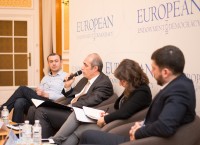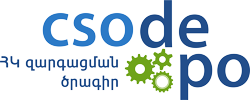
Հայաստան. հանրաքվեն խթան հանդիսացավ նախկինում նմանը չունեցող տեղական խոշոր դիտորդական նախաձեռնության ի հայտ կազմակերպմանը (հայերեն)
In a snap referendum on December 6 to change the constitution, 63.4% of Armenians officially approved the changes. PACE however describes the referendum itself as “driven by political interests instead of the needs of the Armenian public”. The EED-supported Citizens Observer Initiative and the European Platform for Democratic Elections has declared it illegitimate due to an unprecedented number of violations.
One week later, EED invited three Armenian experts to share their analysis with Brussels’ EU institutions and democracy support community of practice.
“After the 2017 parliamentary elections, Armenia will change to a parliamentary system with a stable majority system, allowing the ruling party to control all power positions”, said Armen Grigoryan of the No Pasaran campaign. “De facto, the new constitution will allow President Serzh Sarkisian to stay in power after his second presidential term ends in 2018.”
Grigoryan also stressed that the new constitution significantly decreases citizens’ opportunities to participate in political process. After the 2017 parliamentary elections Armenian citizens will only be able to vote for parliament and for community councils.
“We have had no free and fair elections since 2005,” Levon Barseghyan from the Asparez Journalists’ Club highlighted. “People know that the political process takes place without their say”, followed Hovsep Khurshudyan of the EaP Civil Society Forum.
Grigoryan described the government’s reaction to their debates and rallies to discuss the referendum in several towns: “They tried to stop a youth rally. They pressured the local hotel owners to not provide them meeting rooms.”
Despite such challenges and the outcome of the referendum, Levon Barseghyan pointed to one clear success: “For the first time in the history of Armenia we organised a local independent observation mission covering one fourth of all polling stations with over 1,000 observers. We are determined to prepare ourselves for the 2018 presidential elections”.
As part of the Citizen Observer Initiative, which united four local CSOs, Barseghyan coordinated the voting observation in Armenia’s Shirak region. They submitted hundreds of complaints that are waiting to be properly investigated.
The observation mission was not the only citizen initiative that the referendum inspired. Armenians were very active on social media, and humoristic cartoons addressing the wide-scale fraud were widely shared.
The Armenian activists and their audience expressed frustration at the the low level of EU engagement and response to the referendum. “We see that the attitude of big players such as the EU and the US are very often linked to geopolitical interests”, stated Khurshudyan. The speakers attributed the EU’s absence in the debate to the recent negotiations with Armenia on the partnership agreement.
Some argued that in a parliamentary republic Armenia’s oppositional parties will have a chance to become stronger, but Khurshudyan refuted the argument: “These parties only have two sources of funding. They either apply for state funding which is not even sufficient to cover the running costs of one office or they rely on private donations. A lot of resources are needed to develop a strong opposition.”
The next challenge for Armenian civil society will be to push for improvements to the electoral code, due to be passed by June 2016. The publication of voters’ lists is one of their key demands. As the December 6 referendum was mocked for its many “dead” or “fictional voters”, this is a reform that could make a transparent difference to Armenia’s democracy.
The original source can be found here.
